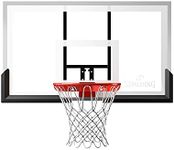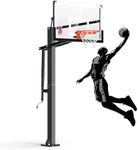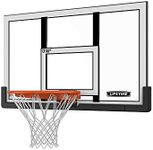Buying Guide for the Best Basketball Hoop And Backboard
Choosing the right basketball hoop and backboard can greatly enhance your playing experience, whether you're a casual player or a serious athlete. It's important to consider where you'll be using the hoop, who will be using it, and how often it will be used. By understanding the key specifications, you can make an informed decision that best suits your needs and preferences.Backboard MaterialThe backboard material affects the durability and performance of the hoop. Common materials include polycarbonate, acrylic, and tempered glass. Polycarbonate is the most durable and is great for outdoor use, but it doesn't offer the best rebound. Acrylic provides a better rebound than polycarbonate and is also suitable for outdoor use. Tempered glass offers the best rebound and is used in professional settings, but it's more fragile and best suited for indoor use. Choose based on where you'll be playing and how important rebound quality is to you.
Backboard SizeBackboard size can impact your playing experience. Sizes typically range from 44 inches to 72 inches. Smaller backboards (44-54 inches) are suitable for casual play and smaller spaces. Medium-sized backboards (54-60 inches) offer a balance between playability and space requirements. Larger backboards (60-72 inches) are ideal for serious players and mimic professional play. Consider the space you have available and your level of play when choosing the size.
Rim TypeThe rim type affects the durability and playability of the hoop. Standard rims are basic and less expensive, suitable for casual play. Breakaway rims have a spring mechanism that allows the rim to flex under pressure, reducing the risk of damage and making them ideal for dunking. Pro-style breakaway rims offer the best performance and durability, similar to what is used in professional basketball. Choose based on how intensely you plan to play and whether dunking is a priority.
Height AdjustmentHeight adjustment allows you to change the height of the hoop, making it versatile for different age groups and skill levels. Some hoops offer a fixed height, while others can be adjusted, typically between 7.5 to 10 feet. Easy-to-use mechanisms like crank or pneumatic systems are preferable for frequent adjustments. Consider who will be using the hoop and whether you need the flexibility to adjust the height.
Mounting TypeThe mounting type determines how and where the hoop can be installed. Portable hoops are easy to move and set up, making them great for driveways or temporary setups. In-ground hoops are more stable and durable, ideal for permanent installations. Wall-mounted hoops save space and are good for garages or indoor play. Choose based on your available space, whether you need portability, and how permanent you want the installation to be.
Pole and Base StabilityThe stability of the pole and base affects the overall sturdiness of the hoop. Portable hoops have a base that can be filled with sand or water, while in-ground hoops are cemented into the ground. Thicker poles and larger bases provide better stability and reduce shaking during play. Consider how stable you need the hoop to be, especially if you plan on intense play or dunking.




















